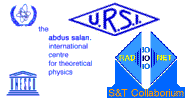|

|
|
|
|
|
|
|
|
|

|
|
ICTP
- URSI
SCHOOL ON DIGITAL AND MULTIMEDIA COMMUNICATIONS USING
TERRESTRIAL AND SATELLITE RADIO
LINKS
12th
February - 2nd March
2001 ,
Trieste
(Italy)
|
|
|
-
|
|
|
|
|
|
|
|
|
Laboratory
Diary: Friday 23rd
february
|
|
|
|
|
Laboratory Diary: friday 23rd february
--------------------------------------
Date: Fri, 23 Feb 2001 23:58:01 +0100 (MET)
Prepared by: Adewara Olakanmi Adekunle
LABORATORY DIARY FOR 23/2/01
CASE STUDY PRESENTATION
The trio of Nohe M. BHAIRY, Nazim HABBANI and Muhammad ALKAROURI presented
the first case study on "NETWORKING and INTERNET SERVICES in Khartoom
University" all from the university of Khartoum, Sudan.
The described the Network Infrastructure existing presently in the
Institution with respect to the geographical locations and spread, types
of technology used and topology employed. There exists separate LANs in
each of the faculties, which are all, connected to the central
communication room.
The external link to the Internet is facilitated by a Zaknet satellite
connection and Data Cloud frame relay connections. There are plans to
expand the network and divers solutions were proffered.
The Second presentation was made by SHAHIN, Kussai with the A.E.C.S in
Damascus, Syria. Highlights of his presentation were the peculiar problems
being faced in a bid to provide Computer network services at the research
institute at which he works. Such challenges include the difficulty in
securing permission to connect wireless LANs in his country, the need for
an increase in the level of awareness, the prohibitive Infrastructural and
Service- Provider costs involved with providing Internet services.
The present network has the farthest node at an approximate distance of
about 200km from the "control center"; Internet services are provided by
Dial-up.
The described a novel idea of accounts sharing using a proxy server, which
allows multiple users to connect to the Internet.
Comming up next was Razvan COCA from the National Institute for R&D of of
Materials Physics at Romania. He delivered a paper describing the
Computer network at Magurele physics platform describing some milestones
in the evolution of of the computer Network at the Institute. He was quick
to point out the role of Spread spectrum radio technology in the rapid
growth of the Netork. He described the use of some network applications;
MOSIX, used for load balancing and the development of a web based index
for the national Physics Library. These applications are "real world" and
"real time" applications. Projections for the future expansion were also
proposed with bandwidth and radio links being major issues.
After a short break, Olumide ADEWALE delivered his paper titled "Internet
Telephony: Benefits, options, problems and solutions". He describedthe
evolution of Internet telephony taking into consideration the technology
itself, the portending implications to POT (Plain old Telephony), the
social implications and possible solutions. He made available some
information amongst which were charts indicating current trends in the
Industry.
ABIONA, Olatunde and ADEWARA Olakanmi from the Obafemi Awolowo University
presented a case study on "Linking rural health facilities to the Internet
using packet radio in developing countries".
A brief introduction was immediately followed by a description of Packet
Radio technology, the enabling protocols and equipment. Its suitability to
the proposed usage was examined in the context of cost, efficiency and
ease of deployment. The topology, bandwidth, connectivity options of the
OAU Network was also discussed in a bid to find out how suitable it will
be in the provision of the Internet Services required via Packet radio.
Last but not the least was an interesting presentation by GOPARKUMA,
Binoy on " A compact mobile telephone handset antenna with reduced
radiation hazards". He described experiments made to investigate the
effects of radiated electromagnetic energy emitted during the use of a
mobile phone handset. The novel microstrip antenna configuration (for the
handset) having lower radiation intensity in the direction of the user was
discussed; this was in addition to the low production cost of the hand
set.
It is worthy to note that the four Computer Networks described in the
course of the presentation were not without the contributions, and or
direct involvement of the ICTP.
After lunch, the class directed by FONDA, Carlos took some exercises on
the installation and use of "Network Monitoring Techniques" software
on a LINUX platform. Thus ending a very hectic day.
Olakanmi
 Back
to the School Home Page
Back
to the School Home Page
updated 24 February
2001, © 2001 ICTP-ARPL, HTML by cfonda
![]()
